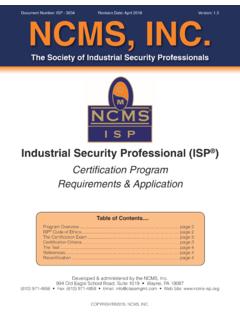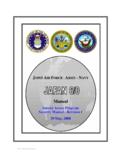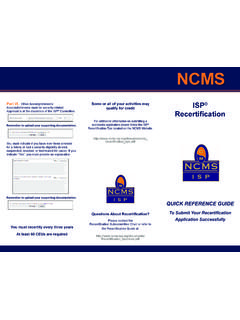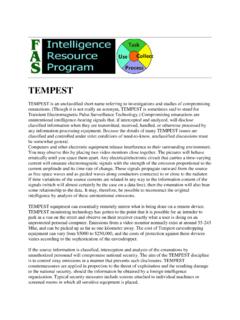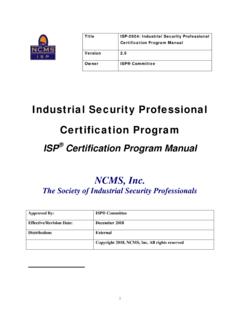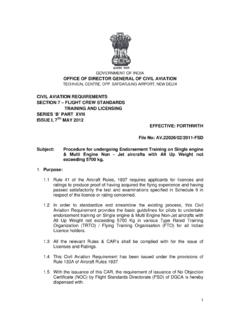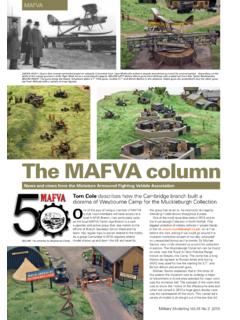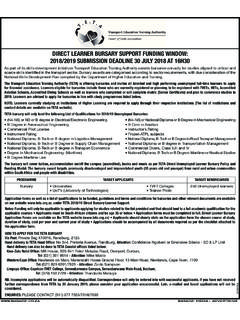Transcription of COMSEC Awareness Training - NCMS, Inc.
1 I COMSEC Awareness Training Student Reading Material June 2005 Security Solutions Group FOR Training PURPOSES ONLY ii Contents PREFACE .. iv Section 1. 1-1 PURPOSE AND SCOPE .. 1-1 COURSE OBJECTIVES .. 1-1 COURSE PREREQUISITES .. 1-1 Section 2. COMSEC 2-1 Section 3. Transmission Security (TRANSEC).. 3-1 MODES OF TRANSMISSION .. 3-1 ELECTROMAGNETIC 3-1 NON-ELECTROMAGNETIC 3-2 Section 4. Cryptographic 4-1 Section 5. Physical 5-1 STORAGE OF CLASSIFIED OR SENSITIVE MATERIALS .. 5-1 Secret and 5-1 Sensitive but Unclassified (SBU) 5-1 For Official Use Only (FOUO) .. 5-1 HANDLING AND USING MATERIALS .. 5-2 During Working 5-2 Removal From 5-2 End of Duty 5-2 Taking Work Home .. 5-2 CONTROL ACCESS AREA (CAA) .. 5-3 Access Authorization .. 5-3 Escorted Access .. 5-3 METHODS OF IDENTIFICATION .. 5-3 Personal 5-4 Access 5-4 Security 5-4 Section 6.
2 Emissions Security .. 6-1 6-1 TEMPEST COUNTERMEASURES .. 6-1 iii Section 7. Information and Classifications .. 7-1 MARKED INFORMATION AND 7-1 TOP SECRET .. 7-1 SECRET .. 7-1 CONFIDENTIAL .. 7-1 FOR OFFICIAL USE ONLY (FOUO) .. 7-1 SENSITIVE BUT UNCLASSIFIED (SBU) 7-1 UNMARKED INFORMATION AND MATERIALS .. 7-2 Section 8. Disclosing 8-1 Authorized Disclosure .. 8-1 Unauthorized 8-1 UNINTENTIONAL DISCLOSURES .. 8-1 Unaware of 8-1 Trapped by 8-2 Awe of Position .. 8-2 Emotional Hazard .. 8-2 Failure to Think .. 8-3 ATTEMPTS TO DISGUISE 8-3 Talk-Around .. 8-3 Self-Made References .. 8-3 Paraphrasing .. 8-3 Incomplete 8-4 Section 9. Security Incident .. 9-1 Personnel Security Incidents .. 9-1 Examples of Personnel Security 9-1 Physical Security Incidents .. 9-1 Examples of Physical Insecurities:.. 9-1 Cryptographic 9-2 Examples of Cryptographic Insecurities.
3 9-2 REPORTING INSECURITIES .. 9-2 iv PREFACE Omitron Security Solutions Group has developed this package to prepare personnel for the duties required in the handling and accounting of COMSEC Materials and Information. All portions of this Training will be under the direct supervision of an instructor/trainer who has been certified by a Responsible COMSEC Officer (RCO) and who has been furnished with an Instructor Guide to assist him/her in conducting this course. Experience has shown that trainees will benefit more from this Training if they study in a place free from noise and distractions and follow a planned schedule of completion. This package is designed to acquaint the student with the general Communications Security ( COMSEC ) concepts. If you have questions about the format or contents of this Training package, you may contact Derek Herring at 281-853-3056 or email or v This page intentionally left blank 1-1 Section 1.
4 Introduction PURPOSE AND SCOPE This Training will be used by personnel whose duties involve the maintenance, operation or control of equipment or systems used in protection of sensitive and classified information or operations. This Training will provide the trainee with information relating to Communication Security ( COMSEC ) and related Physical Security measures as well as their importance to protecting National Security. COURSE OBJECTIVES Upon completion of this Training the trainee will have an understanding of: 1. Communications Security ( COMSEC ) Elements and Insecurities. 2. TEMPEST Considerations and Protections 3. Security Requirements COURSE PREREQUISITES Individuals wishing to participate in this Training must: 1. Have US Citizenship 2. Be a Permanent Government or Government Contractor Employee 3.
5 Have a position in which their duties require them to have access to or knowledge of classified or sensitive information. 2-1 Section 2. COMSEC Overview You may already be aware of your agency s or contract s security programs by now, and are asking yourself, "Why do I need more information on security?" The answer to this question is simple. Despite all the security Training , security warning posters, and other reminders, classified and sensitive information is still being disclosed to unauthorized personnel. Foreign intelligence-gathering activities continue despite our precautions. Therefore, we must continue to regularly educate all personnel about security, especially in the areas of communication security ( COMSEC ). The success of our security program requires effort from us all. Our coverage of communications security ( COMSEC ) in this course is mainly concerned with the means of communication in which transmitting and receiving information require wire or radiant energy.
6 It should be clear that our National Security is dependent on the security on the systems providing these electronic transfers. Ideally, only the intended or authorized parties receive these transmissions in a usable format, and any unintended or unauthorized receipt of the transmissions is unusable by the recipient. In the following paragraphs we discuss the COMSEC elements used in that protection and the COMSEC security incidents that could jeopardize such protection. ELEMENTS OF COMSEC COMSEC is the protection afforded classified and sensitive information or operations that is achieved by applying the following four elements: 1. Transmission Security (TRANSEC) The protection of information when it is passed between parties. 2. Cryptographic Security The proper design, implementation, use and protection of Cryptographic (Encryption/Decryption) systems used for the protection of information.
7 3. Physical Security The means by which unauthorized parties are denied access to information and materials. 4. Emissions Security The means by which unintentional emanations are limited or stopped from leaving the security of a controlled space. These four elements of COMSEC are used to deny unauthorized persons/parties information of value, to support operational access to systems, and/or to ensure the authenticity of such telecommunications. Why do we need COMSEC ? The answer is simple. COMSEC prevents unauthorized persons from obtaining information of intelligence value and/or gaining access to (would knowledge of be better?) sensitive operations resulting from the interception and analysis of our communications. 3-1 Section 3. Transmission Security (TRANSEC) TRANSEC is that part of communications security that includes all measures (except physical protection) designed to protect transmissions from interception and exploitation by means other than crypto analysis.
8 Everyone must use transmission security, because everyone uses at least the telephone in the performance of their duties. Examples of transmission security include: 1. Changing radio frequencies and call signs. 2. Using message format for classified record communications. 3. Using classification guides to determine whether or not certain information should be sent over unsecure systems. 4. Using cryptographically secured telephones, voice circuits, and air/ground communications systems. 5. Canceling or altering communications patterns to prevent detection of a change from normal traffic flow and volume. 6. Using authentication to ensure validity of receipt of traffic and to counter telecommunications systems intruders. 7. Using authorized codes when unsecure telephone or radiotelephone communications are used. 8. Imposing radio or telephone silence.
9 MODES OF TRANSMISSION For official information to be useful, it is normally passed from one person to another. The various means of passing information are called modes of transmission. These modes of transmission may be electromagnetic or nonelectromagnetic. ELECTROMAGNETIC TRANSMISSION Signs, signals, writing, images, and sounds or information of any type when sent or received by wire, radio, light, or other electromagnetic systems are electromagnetic telecommunications. Modes of electromagnetic transmissions are radio, telephone, television, radar, data-link, teletype, and facsimile. Radio When we talk about radio communications, we normally think of air-to-air, air-to-ground or ground-to-ground. Examples of radio communications include pilots talking to each other or to the control tower and security police talking on their hand-held radios.
10 These forms make up only a small percentage of the total radio communications. Virtually all electromagnetic telecommunication systems 3-2 transmit by radio signals. For example, microwave radio signals can travel well beyond the equipment--as easily as you tune in your favorite radio station at home. Radio is one of the fastest modes of communication because it is available to virtually everyone within an instant. However, because it is impossible to control the number of listeners, radio is also the least secure. Classified information or information of possible intelligence value must never be sent by radio unless approved secure crypto-equipment or codes are used. Telephones The telephone is one of the fastest, most convenient, and most widely used communication modes in use today. All government sites and installations, as well as contractor facilities, are connected to telephone networks.
